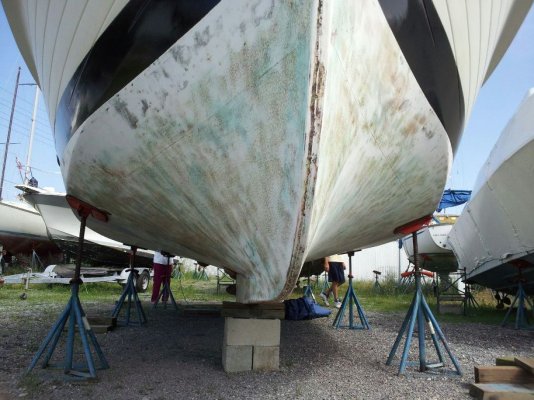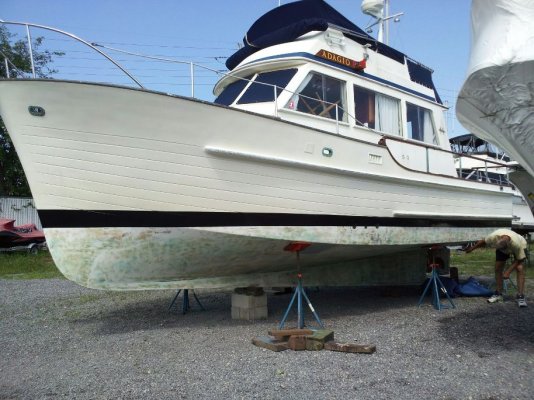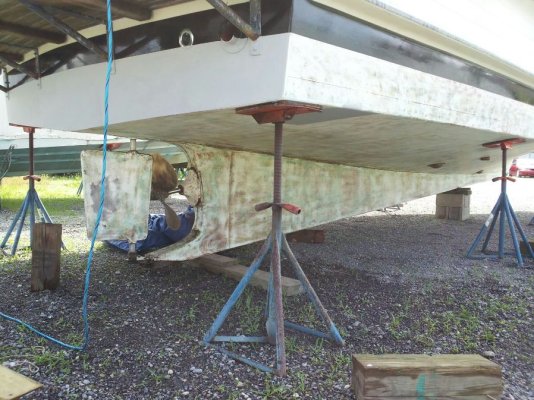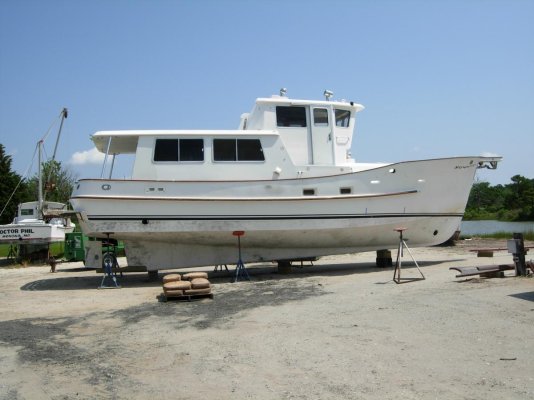You are using an out of date browser. It may not display this or other websites correctly.
You should upgrade or use an alternative browser.
You should upgrade or use an alternative browser.
My Bare Bottom
- Thread starter JohnP
- Start date
The friendliest place on the web for anyone who enjoys boating.
If you have answers, please help by responding to the unanswered posts.
If you have answers, please help by responding to the unanswered posts.
skipperdude
Guru
Looks like the keel edge could use some work.
Is that raw fiberglass showing?
Sd
Is that raw fiberglass showing?
Sd
There are a lot of things you can do to a boat yourself, but removing and then reapplying bottom paint has got to be one of the hardest and dirtiest.
I paid the marina manager to do my last bottom paint job and I'll either pay him again next time or take it to a local yard that often puts bottom jobs on sale.
Electrical, plumbing, and carpentry work I'll tackle myself.
I paid the marina manager to do my last bottom paint job and I'll either pay him again next time or take it to a local yard that often puts bottom jobs on sale.
Electrical, plumbing, and carpentry work I'll tackle myself.
ben2go
Guru
It would be nice to have a stainless steel keel shoe to give a little protection in case of grounding.Her bottom looks good overall.Can't wait to see the pink bottom and neon green boot strap your doing.
:lol:
:lol:
Bare Bottom
We just finished doing the exact thing with our Willard 30. Undoubtedly the nastiest, dirtiest job. Was yours not tented? Did you sand or???
We scraped, sanded and ground the paint off ours.
We had our cast iron keel coated with two coats of zinc primer then the entire boat with 2 coats of epoxy barrier sprayed on and then two coats of bottom paint sprayed on too. It is back in the water now and ready to go out.
Lots of pictures to document the job for our "Owners Manual". Nice to have it done and know it is there and done well.
We just finished doing the exact thing with our Willard 30. Undoubtedly the nastiest, dirtiest job. Was yours not tented? Did you sand or???
We scraped, sanded and ground the paint off ours.
We had our cast iron keel coated with two coats of zinc primer then the entire boat with 2 coats of epoxy barrier sprayed on and then two coats of bottom paint sprayed on too. It is back in the water now and ready to go out.
Lots of pictures to document the job for our "Owners Manual". Nice to have it done and know it is there and done well.
BruceK
Moderator Emeritus
- Joined
- Oct 31, 2011
- Messages
- 13,347
- Vessel Name
- Sojourn
- Vessel Make
- Integrity 386
Looks like you did the stripping yourselves rather than sandblasting. Congratulations,tough job,we did a dry hard rotary sand of the remaining antifoul and everything else after osmosis work, awful job,the vertical bits were ok,but the rest, lying on your back sanding overhead, in mask and goggles...never again, but yours was a much tougher job. I can`t see any circular spot signs of blister repairs,that`s great. Your speed for engine rpm will leap,nothing like a smooth bottom. BruceK
JohnP
Guru
- Joined
- Dec 13, 2009
- Messages
- 1,361
- Location
- USA
- Vessel Name
- V E N T U R E
- Vessel Make
- 1996 36' Island Gypsy Classic
John:
Did you do the work?
Did you find any blisters?
I did it myself, Scraped by hand, lots of different layers and colors.
Big areas would just practically fall off, then a stuck area would take hours.
Followed with random orbital and 60 grit. Whole thing took a week, the bridge of my nose hurt from wearing a respirator that long.
No blisters, but small white dots long like pimples that were sanded off years ago. Some minor checking in the gelcoat.
Don't thing I would tackle this again.
JohnP
Guru
- Joined
- Dec 13, 2009
- Messages
- 1,361
- Location
- USA
- Vessel Name
- V E N T U R E
- Vessel Make
- 1996 36' Island Gypsy Classic
It would be nice to have a stainless steel keel shoe to give a little protection in case of grounding.Her bottom looks good overall.Can't wait to see the pink bottom and neon green boot strap your doing.
:lol:
How did you know our color scheme?
JohnP
Guru
- Joined
- Dec 13, 2009
- Messages
- 1,361
- Location
- USA
- Vessel Name
- V E N T U R E
- Vessel Make
- 1996 36' Island Gypsy Classic
There are a lot of things you can do to a boat yourself, but removing and then reapplying bottom paint has got to be one of the hardest and dirtiest.
I paid the marina manager to do my last bottom paint job and I'll either pay him again next time or take it to a local yard that often puts bottom jobs on sale.
Electrical, plumbing, and carpentry work I'll tackle myself.
Smart Man!!
JohnP
Guru
- Joined
- Dec 13, 2009
- Messages
- 1,361
- Location
- USA
- Vessel Name
- V E N T U R E
- Vessel Make
- 1996 36' Island Gypsy Classic
Looks like the keel edge could use some work.
Is that raw fiberglass showing?
Sd
Actually there is no damage at all.
The original mold or the process they used resulted in an uneven place along the center of the keel, The sanding was not as effective accross this small lip or bump.
Been that way for 30 years so I think it will stay like this on my watch.
JohnP
Guru
- Joined
- Dec 13, 2009
- Messages
- 1,361
- Location
- USA
- Vessel Name
- V E N T U R E
- Vessel Make
- 1996 36' Island Gypsy Classic
Looks like you did the stripping yourselves rather than sandblasting. Congratulations,tough job,we did a dry hard rotary sand of the remaining antifoul and everything else after osmosis work, awful job,the vertical bits were ok,but the rest, lying on your back sanding overhead, in mask and goggles...never again, but yours was a much tougher job. I can`t see any circular spot signs of blister repairs,that`s great. Your speed for engine rpm will leap,nothing like a smooth bottom. BruceK
Never again for me too. Yes no blister repairs!
ben2go
Guru
psneeld
Guru
Only an idiot would seek counsel and not pay heed. To the boat yard she will go! Thanks for the info...
Whoaaa there nellie...
Most boatyards/surveyors don't know crappola about hydrolysis and blistering.
If you are serious about your bottom...you can take a more methodical approach (much like a general contractor) and make sure every step of the way is necessary and done correctly. The vast majority of boatyards along the Atlantic/Gulf Coasts are NOT capable of making such judgements...you are better off doing some research and then farming out any work you deem necessary. Yes there are yards that specialize in this work and they are gonna do it right.... but at a price that most older trawler owners really cant afford.
Don't jump into anything and don't get out the checkbook just yet. I ground down my bottom into the first roving laminate past the gel and mat....repaired hundreds of blisters and a 5'x5' section that was delaminated halfway through the hull. Yes I have hundreds of man hours into it but only around $1500 into a quoted $30,000 dollar job. So you see it's worth doing your homework and asking around.
BruceK
Moderator Emeritus
- Joined
- Oct 31, 2011
- Messages
- 13,347
- Vessel Name
- Sojourn
- Vessel Make
- Integrity 386
In Sydney, guys such as "Sodablast" will strip an IG36 for around AUD $2500 (still at/above parity). He arrives in a custom fitted truck,sets up screening,takes half a day,(our all over hard sand took me, and my better half, a weekend), works relatively quietly,recovers the grit material,cleans up,and leaves a hull ready for whatever work is required. Shipwrights working on my hull said, in hindsight, it was the better way. BruceKIf you are serious about your bottom...you can take a more methodical approach...you are better off doing some research and then farming out any work you deem necessary. Yes there are yards that specialize in this work and they are gonna do it right.... but at a price that most older trawler owners really cant afford.
.
psneeld
Guru
Depends...if more material needs to come off than paint...like the gel or a layer of mat, etc...the cost skyrockets sometimes.In Sydney, guys such as "Sodablast" will strip an IG36 for around AUD $2500 (still at/above parity). He arrives in a custom fitted truck,sets up screening,takes half a day,(our all over hard sand took me, and my better half, a weekend), works relatively quietly,recovers the grit material,cleans up,and leaves a hull ready for whatever work is required. Shipwrights working on my hull said, in hindsight, it was the better way. BruceK
Also..not every soda blast guy knows or understands hydrolysis/blistering...yeah...they are great at removing paint...but you better check if you need more than that done.
In Sydney, guys such as "Sodablast" will strip an IG36 for around AUD $2500 (still at/above parity). He arrives in a custom fitted truck,sets up screening,takes half a day,(our all over hard sand took me, and my better half, a weekend), works relatively quietly,recovers the grit material,cleans up,and leaves a hull ready for whatever work is required. Shipwrights working on my hull said, in hindsight, it was the better way. BruceK
Bruce: what made you soda-blast before anti-fouling? Did you have blisters to repair? Just wondering if there's a point in a non-blistering hull's life when taking back to bare is recommended.
psneeld
Guru
Bruce: what made you soda-blast before anti-fouling? Did you have blisters to repair? Just wondering if there's a point in a non-blistering hull's life when taking back to bare is recommended.
Often a boat hasn't had an ablative type paint on it and there are so many layers it is weight, roughness and the inability to get new paint to hold on that causes people to blast or grind down.
No absolutes...just when it feels right.
- Joined
- Mar 17, 2012
- Messages
- 4,279
- Location
- Australia
- Vessel Name
- Insequent
- Vessel Make
- Ocean Alexander 50 Mk I
If I remember correctly they said $8500 for sodablasting. So it doesn't 'feel right' just yet.
If the pressure wash removed a bunch of layers and exposed gel coat then I just scraped any additional loose bits off, smoothed the edges a bit and put on some Primocon before antifouling. Sure it isn't perfectly smooth but I'm not racing anyone anywhere.
If the pressure wash removed a bunch of layers and exposed gel coat then I just scraped any additional loose bits off, smoothed the edges a bit and put on some Primocon before antifouling. Sure it isn't perfectly smooth but I'm not racing anyone anywhere.
BruceK
Moderator Emeritus
- Joined
- Oct 31, 2011
- Messages
- 13,347
- Vessel Name
- Sojourn
- Vessel Make
- Integrity 386
We didn`t, but wished we had. The "quote" was from the SodaStrip man doing another boat at the yard. We did have plenty of blisters to repair, the post repair full dry sand was worthwhile but a truly nasty job, even with face masks. Before I bought, the hull had been soda stripped and antifouled, the blisters exposed were mostly just left(!), a few were bogged, 20K came off the price post survey. The bill/receipt for the prior work was "misleading", as the deceased owners son and I discovered together.Bruce: what made you soda-blast before anti-fouling? Did you have blisters to repair? Just wondering if there's a point in a non-blistering hull's life when taking back to bare is recommended.
If you get a significant antifoul build up it is worth stripping to get back to a fair surface. It made a big difference with a yacht I had years ago, much quicker. It is usually followed by an epoxy coat if taken right back, and protective coats to prevent osmosis, before the a/f. I think it gets to a point where you have to do it, if you can save getting to that by sanding and or ablative a/f, do.
Looks like you're doing a pretty thorough job
I helped a buddy re do the bottom on his 39' sailboat.
For the quote that he'd gotten, we all agreed afterward that next time we'll all pitch in and hire it done. I'm getting too old for this crap
I'm with psneeld though, don't just plop down your hard earned coin and walk away. Either supervise each steep, or sub it out.
OD

I helped a buddy re do the bottom on his 39' sailboat.
For the quote that he'd gotten, we all agreed afterward that next time we'll all pitch in and hire it done. I'm getting too old for this crap
I'm with psneeld though, don't just plop down your hard earned coin and walk away. Either supervise each steep, or sub it out.
OD
BruceK
Moderator Emeritus
- Joined
- Oct 31, 2011
- Messages
- 13,347
- Vessel Name
- Sojourn
- Vessel Make
- Integrity 386
The soda blast guys here set up a tent thing, and collect the blasting agent. It`s a clean tidy process, they are all set up and have a special truck with everything they need.
Someone sandblasted a steel boat next to mine when it was in a shed for osmosis work etc. The noise and the mess were horrendous, it took forever to get the boat clean. (It was at the old Halvorsen factory site at Putney.)
That sounds like a great deal Ted. Nothing gets done to a boat here for $50ph. A Sodablast job for my boat was estimated at $2500 "cash".
Someone sandblasted a steel boat next to mine when it was in a shed for osmosis work etc. The noise and the mess were horrendous, it took forever to get the boat clean. (It was at the old Halvorsen factory site at Putney.)
That sounds like a great deal Ted. Nothing gets done to a boat here for $50ph. A Sodablast job for my boat was estimated at $2500 "cash".
markpierce
Master and Commander
- Joined
- Sep 25, 2010
- Messages
- 12,557
- Location
- USA
- Vessel Name
- Carquinez Coot
- Vessel Make
- penultimate Seahorse Marine Coot hull #6
psneeld
Guru
Possibly the prices for soda blasting are all over the map dues to environmental protection or insurance reasons....costs the yard may incur that they pass along.
Ted..that would have been a great price...usually $40-$60 a foot is the pricing I am familiar with And that was 2012 when I was doing my boat.
Ted..that would have been a great price...usually $40-$60 a foot is the pricing I am familiar with And that was 2012 when I was doing my boat.






